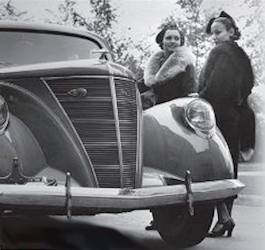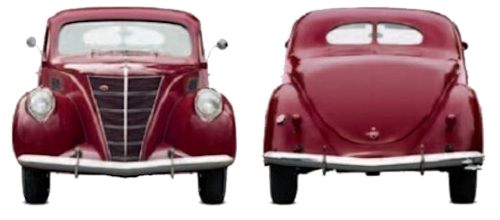Traditionally associated with high-priced luxury, the Ford-owned Lincoln marque offered buyers its least-expensive model to date with the 1936 Zephyr. Featuring Lincoln’s first unibody construction-in all-steel-and powered by a new V12 engine, the Zephyr thrilled with its daring, sleek design. Launched at the 1936 New York Auto Show, the Zephyr became one of the marque’s best-selling cars of the 1930s and proved that streamlining was the future.

AERODYNAMIC STYLING may not have paid off for Chrysler in 1934 with its radical Airflow range, but that didn’t prevent Ford from introducing its own sleek model two years later. Though a risky venture, the Lincoln-Zephyr was underpinned by a smart marketing move-offering cut-price luxury at a time when other top-end manufacturers were going to the wall. Initially available as a two-door fastback sedan or four-door sedan coupe, this three-window coupe and a convertible coupe were added to the range in 1937. World War II put car production on hold until 1942.

SPECIFICATIONS Lincoln-Zephyr (1936)
- Model Lincoln-Zephyr (1936)
- Assembly Detroit, USA
- Production 29,997 (1937)
- Construction Steel unibody (monocoque)
- Engine 267 cu in (4,378 cc), V12
- Power 110 bhp
- Transmission Three-speed manual
- Suspension Front and rear transverse-leaf springs
- Brakes Drums front and rear
- Maximum speed 90 mph (145 km/h)
When the model returned in 1946, the Zephyr name was dropped, but the car continued for two more glorious years under the Lincoln banner. The sweeping, teardrop lines of the Zephyr were in marked contrast to offerings from other contemporary luxury manufacturers such as Cadillac and Packard, and would influence the direction their future ranges would take. Within Lincoln, the model provided the blueprint for one of America’s most seminal automobiles, the first-generation Continental from 1939 to 1948.

Road presence
Dominated by its distinctive grille and dramatic, sweeping curves, the front of the Lincoln-Zephyr oozed Art Deco panache.
The model was originally conceived by John Tjaarda of the Briggs Manufacturing Company that had supplied Ford and other car makers with bodies for several years.
The Zephyr’s front end was then reworked by Edsel Ford and in-house designer Eugene “Bob” Gregorie.
Rail to road
The Zephyr model name came from a futuristically styled, steel-bodied diesel locomotive called the Pioneer Zephyr.
It operated from 1934 and set several speed records during its time spent promoting rail travel in the United States.
Lincoln-Zephyr interior
Despite being the cheapest Lincoln to date, there was no corner-cutting inside the Zephyr cockpit. Some models, mainly convertibles, were upholstered in red, brown, or gray leather, and featured wooden dashboards. From 1937 to 1940 the Zephyrs had an unusual instrument layout, with the main dials positioned in the center of the dashboard; from 1940, the speedometer was moved in front of the driver. The dashboard color was matched to the exterior paint color.
Lincoln-Zephyr exterior
Attention to detail was evident on the Lincoln-Zephyr, but marketing material also stressed the benefits of the combined chassis and body unit-“No other gives the same protection, the same comfort.” Although the svelte profiles were gradually given straighter edges from 1942 onward, by this time the Zephyr had made its mark as America’s aerodynamic style leader.
Under the hood Lincoln-Zephyr
Advertised by Lincoln as a “silent, alert powerhouse,” the Zephyr’s V12 block was based on Ford’s flathead V8 engine. It was the only engine of this type available in its sector at the time. Capable of returning a respectable 14–18 miles per gallon (6–8 kilometers per liter), the 110 bhp unit was expanded in 1940 to 292 cu in (4,785 cc), which generated an additional 10 bhp. The final capacity change came in 1942, when a power plant with 302 cu in (4,949 cc) was fitted.